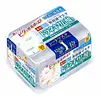What's inside
What's inside
 Key Ingredients
Key Ingredients

 Benefits
Benefits

 Concerns
Concerns

 Ingredients Side-by-side
Ingredients Side-by-side

Water
Skin ConditioningTranexamic Acid
AstringentButylene Glycol
HumectantGlycerin
HumectantDipropylene Glycol
HumectantClematis Vitalba Leaf Extract
Skin ConditioningSpiraea Ulmaria Flower Extract
Skin ConditioningEquisetum Arvense Extract
AstringentHedera Helix Extract
AntimicrobialSambucus Nigra Extract
Skin ConditioningFucus Vesiculosus Extract
EmollientDisodium EDTA
Xanthan Gum
EmulsifyingSodium Citrate
BufferingHydroxypropyl Methylcellulose
Emulsion StabilisingSodium Metabisulfite
AntioxidantDisodium Phosphate
BufferingMethylparaben
PreservativeWater, Tranexamic Acid, Butylene Glycol, Glycerin, Dipropylene Glycol, Clematis Vitalba Leaf Extract, Spiraea Ulmaria Flower Extract, Equisetum Arvense Extract, Hedera Helix Extract, Sambucus Nigra Extract, Fucus Vesiculosus Extract, Disodium EDTA, Xanthan Gum, Sodium Citrate, Hydroxypropyl Methylcellulose, Sodium Metabisulfite, Disodium Phosphate, Methylparaben
Water
Skin ConditioningGlycerin
HumectantNiacinamide 2%
SmoothingDipropylene Glycol
HumectantHydroxyacetophenone
AntioxidantArginine
MaskingCarbomer
Emulsion StabilisingSodium Ascorbyl Phosphate
AntioxidantPolyglyceryl-10 Laurate
Skin ConditioningPolyglyceryl-4 Laurate
EmulsifyingAllantoin
Skin ConditioningHydroxyethylcellulose
Emulsion StabilisingCaprylyl/Capryl Glucoside
CleansingButylene Glycol
HumectantCaprylyl Glycol
EmollientDisodium EDTA
Parfum
Masking1,2-Hexanediol
Skin ConditioningSodium Hyaluronate
HumectantWater, Glycerin, Niacinamide 2%, Dipropylene Glycol, Hydroxyacetophenone, Arginine, Carbomer, Sodium Ascorbyl Phosphate, Polyglyceryl-10 Laurate, Polyglyceryl-4 Laurate, Allantoin, Hydroxyethylcellulose, Caprylyl/Capryl Glucoside, Butylene Glycol, Caprylyl Glycol, Disodium EDTA, Parfum, 1,2-Hexanediol, Sodium Hyaluronate
 Reviews
Reviews

Ingredients Explained
These ingredients are found in both products.
Ingredients higher up in an ingredient list are typically present in a larger amount.
Butylene Glycol (or BG) is used within cosmetic products for a few different reasons:
Overall, Butylene Glycol is a safe and well-rounded ingredient that works well with other ingredients.
Though this ingredient works well with most skin types, some people with sensitive skin may experience a reaction such as allergic rashes, closed comedones, or itchiness.
Learn more about Butylene GlycolDipropylene Glycol is a synthetically created humectant, stabilizer, and solvent.
This ingredient helps:
Dipropylene glycol is technically an alcohol, but it belongs to the glycol family (often considered part of the ‘good’ alcohols). This means it is hydrating and gentle on skin unlike drying solvent alcohols like denatured alcohol.
As a masking agent, Dipropylene Glycol can be used to cover the smell of other ingredients. However, it does not have a scent.
Studies show Dipropylene Glycol is considered safe to use in skincare.
Learn more about Dipropylene GlycolDisodium EDTA plays a role in making products more stable by aiding other preservatives.
It is a chelating agent, meaning it neutralizes metal ions that may be found in a product.
Disodium EDTA is a salt of edetic acid and is found to be safe in cosmetic ingredients.
Learn more about Disodium EDTAGlycerin is already naturally found in your skin. It helps moisturize and protect your skin.
A study from 2016 found glycerin to be more effective as a humectant than AHAs and hyaluronic acid.
As a humectant, it helps the skin stay hydrated by pulling moisture to your skin. The low molecular weight of glycerin allows it to pull moisture into the deeper layers of your skin.
Hydrated skin improves your skin barrier; Your skin barrier helps protect against irritants and bacteria.
Glycerin has also been found to have antimicrobial and antiviral properties. Due to these properties, glycerin is often used in wound and burn treatments.
In cosmetics, glycerin is usually derived from plants such as soybean or palm. However, it can also be sourced from animals, such as tallow or animal fat.
This ingredient is organic, colorless, odorless, and non-toxic.
Glycerin is the name for this ingredient in American English. British English uses Glycerol/Glycerine.
Learn more about GlycerinWater. It's the most common cosmetic ingredient of all. You'll usually see it at the top of ingredient lists, meaning that it makes up the largest part of the product.
So why is it so popular? Water most often acts as a solvent - this means that it helps dissolve other ingredients into the formulation.
You'll also recognize water as that liquid we all need to stay alive. If you see this, drink a glass of water. Stay hydrated!
Learn more about Water